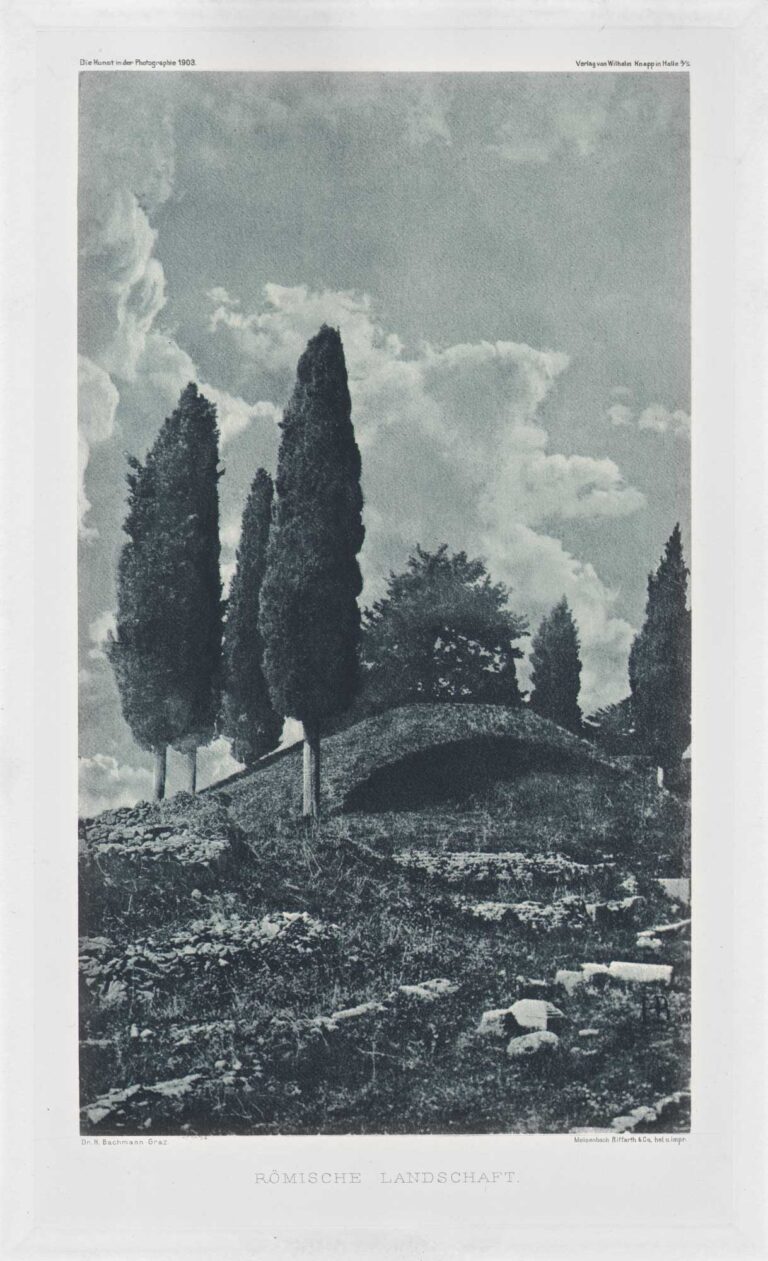
Moorland
The location of this photograph is on Adel Moor in Yorkshire, England. The Moor is believed to be part of Adel Woods, set between the suburbs of Adel and Alwoodley outside Leeds.
Of Horsley Hinton’s works, four of which were in the Salon, Adel Moor (see p. 49) seemed to me the best. A boldly treated square barn occupies one side of the picture, while the foreground is a meadow, from which only a few flower heads stand out. This simplicity offers a very pleasant calm to the eye, but the clouds stand out a little too much and spoil this feeling somewhat. – Camera Kunst, 1903, p. 100 (translated)
Alfred Horsley Hinton: 1863-1908
Alfred Horsley Hinton was an English landscape photographer, best known for his work in the pictorialist movement in the 1890s and early 1900s. As an original member of the Linked Ring and editor of The Amateur Photographer, he was one of the movement’s staunchest advocates. Hinton wrote nearly a dozen books on photographic technique, and his photographs were exhibited at expositions throughout Europe and North America.
Hinton was born in London in 1863. He attended art school with the hopes of becoming a painter, and became proficient in oil, watercolors, and black-and-white drawing. By 1882, he had discovered photography, and was hired as editor of the Photographic Art Journal in 1887. Hinton briefly worked for a company in Blackfriars selling photographic equipment before taking over a branch portrait studio of Ralph W. Robinson in Guildford in 1891. In 1893, he was hired as editor of The Amateur Photographer, a position he retained for the rest of his life.
During the late 1880s, Hinton became one of a growing number of photographers who believed that photography should be considered a form of high art, a movement that became known as pictorialism. Pictorialism, according to Hinton, employed “the image of concrete things to create abstract ideas.” He exhibited several photographs at an early-1890s Leeds exposition described by his contemporary, Alexander Keighley, as the first pictorialist exposition, and was one of the original members of the Linked Ring, an organisation formed in 1892 to promote photography as a fine art.
Hinton helped organise the Photographic Salon in 1893, and became the primary English correspondent for the Bulletin of the French pictorialist group, the Photo Club of Paris. A poll conducted by Photographic Life in 1897 found Hinton to be the most popular photographer-exhibiter.
Hinton’s staunch defence of pictorialism gained him numerous enemies. His attempt to join the Royal Photographic Society touched off a fierce debate among the readers of the British Journal of Photography, with numerous letters written both in support of his membership and against it. Hinton was a member of the Royal Photographic Society between 1889 and 1893. He continued his defence of pictorialism into the following century, and was unimpressed with the rise of the “American School,” which included photographers such as Edward Steichen (Steichen once referred to Hinton as a “slimy snake”).
During the early 1900s, Hinton was a regular contributor to the London Times, The Daily Telegraph, the Daily Graphic, and the Yorkshire Post, and was frequently called upon to judge photo contests. In 1904, he oversaw the British photographic exhibit at the St. Louis World’s Fair, and he spent his last years writing manuals (“Little Books”) to teach photographers basic techniques. In February 1908, he fell ill while returning from a trip to the Scottish Photographic Salon in Aberdeen, and died at his home in Woodford Green. The Royal Photographic Society held an exclusive exhibit of Hinton’s work in April 1908. -Wikipedia (2024)
The Linked Ring
Alfred Horsley Hinton was a founder member on 27 May, 1892. His Pseudonym was Comptroller of the Exchequer. He was a center link for periods in 1892, 1898, 1900 and 1907. He was severed upon his death on 8 April, 1908. (1.)
- The Linked Ring:The Secession in Photography 1892-1910, Margaret Harker: 1979, p. 184



